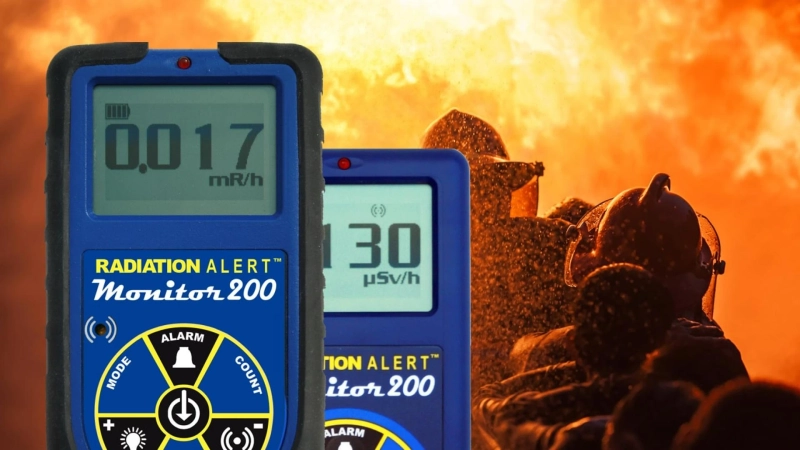The presence of radioactive materials in a wide range of workplaces introduces some well-known health hazards. Most people will have some idea of how the radiation level matters in terms of the risk. Note that there are also three ways of characterizing radiation levels as well as several different ways to measure the amount of radiation and different means of radiation detection. Understanding this subject is helpful for employees, managers, and stakeholders for a variety of reasons, mainly for the protection of human health through the effective use of radiation monitoring equipment. The first step to understanding radiation levels is to understand how we measure the amount of radiation.
Radiation Detection and Methods of Measuring Radiation Levels
Radiation comes in several varieties with different health effects and risks. Alpha radiation, beta radiation, x-rays, and gamma rays. Let’s review the ways that radiation can be measured for different purposes, for example, the amount of radiation from a source, the natural radiation level in a locale, or the amount of radiation a person has absorbed. The US Centers for Disease Control describes three kinds of measurements that radiation monitoring equipment can use:
Amount or radioactivity – Curies (Ci) describe the amount of radiation coming from a sourceAmbient radiation level – The background radiation in an area. Measured in Sieverts per hour (Sv/H) Roentgen per hour (R/h) or rems per hour (rem/h)Individual radiation dose – May be measured in rads, rem, or Sieverts (sometimes millisieverts)Each type of measurement has its uses and individuals who are around radiation need to be familiar with them. What matters most will depend on your work. In a mine that exposes radioactive material, like uranium ore, the ambient radiation level is important. Workers in a medical lab or research center that uses radioisotopes need to monitor their radiation doses.
To review, radiation is of two types: ionizing and non-ionizing. Ionizing radiation is made of particles that can knock electrons out of their orbits, causing those atoms to become charged, or ionized. The other type of radiation, which includes electromagnetic emissions from microwaves and smartphones, is not capable of ionizing atoms. Ionizing radiation is what tends to cause serious health problems and what radiation detection gear is mostly used for.
Health Issues
Everyone knows that radiation exposure can, over time, lead to health problems including cancer. Intense exposure can cause radiation sickness and death. Exposure can also alter your DNA, which may lead to other problems. What might happen depends on the level of exposure and the type of radiation. Not everyone is affected in the same way by exposure to radiation, with infants being more vulnerable than adults. Brief exposure to an intense dose of radiation can also cause radiation burns, but that is not a situation you would encounter in most commercial or industrial settings. The main goal of radiation detection and monitoring is more about protecting people from the insidious long-term effects of radiation exposure.
Protecting the Public and Employees
Organizations that handle radioactive material in testing, manufacturing, or medical treatment and research all need to monitor employees’ exposure over time. SE International offers a wide selection of radiation detectors, radiation monitoring equipment, and radiation monitoring software for commercial, industrial, and scientific/healthcare customers.
The US Occupational Health and Safety Administration (OSHA) sets occupational exposure standards. They require that radiation exposure be As Low As Reasonably Achievable (the ALARA principle). The standards are a bit complicated beyond that, but the general rule is that workers may be exposed to no more than 1.25 rem per calendar quarter.
How much radiation is that? Compare 1.25 rem per calendar quarter with the amount of radiation people encounter in other ordinary activities like air travel or getting dental x-rays. Our natural radiation exposure averages about 2.4 mSv (or approximately 300 millirems) per year, or a tiny fraction of a rem. One Sv is equal to 100 rem. OSHA has a standard of 5,000 millirems per year on top of that natural radiation exposure we all get from the natural environment.
Educating Employees, Vendors, and the Public
Radiation detection is a technically complex topic. It can be difficult to avoid some complexity in explaining radiation-related hazards. However, doing so is important to build trust with a range of stakeholders. A medical center that does lots of diagnostic imaging needs to communicate about the level of exposure that patients face. Employees who work with scanners and x-ray machines also need to know how much radiation exposure they can expect, what the law allows, and how radiation exposure is measured.
If you know how to translate things like millisieverts and rem into real-world language, it is easier to communicate with the public and nontechnical staff about radiation-related matters. Hearing that the expected dosage will be about 1 rem per year is mystifying to many people. However, if you compare the exposure to taking regular international flights or getting a few x-rays a year that is something normal, something people do not see as threatening, either. In this case, 1 rem a year on top of normal daily exposure is not much of a risk.
Radiation Detection and Monitoring & Radiation Levels
Radiation exposure is a reality in many commercial, healthcare, and scientific settings so accurately understanding radiation levels is important for long-term health. Therefore, good radiation detection tools are so important, quite apart from what regulations require. S.E. International sells dosimeters, analog and digital radiation detectors, and radiation monitoring equipment to suit a wide variety of commercial, industrial, and research applications. Visit our site to review our selection of hardware and software.


